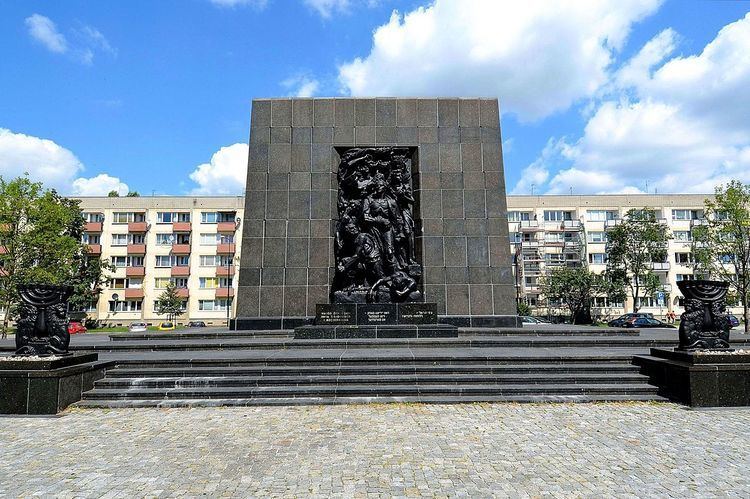 | ||
Hours Open today · Open 24 hoursSaturdayOpen 24 hoursSundayOpen 24 hoursMondayOpen 24 hoursTuesdayOpen 24 hoursWednesdayOpen 24 hoursThursdayOpen 24 hoursFridayOpen 24 hours Similar POLIN Museum of the Histor, Nożyk Synagogue, Chopin Statue - Warsaw, Warsaw Uprising Monument, Jewish Cemetery - Warsaw | ||
Warsaw in your pocket monument to the ghetto heroes
The Ghetto Heroes Monument (Polish: pomnik Bohaterów Getta) is a monument in Warsaw, Poland, commemorating the Warsaw Ghetto Uprising of 1943 during the Second World War. It is located in the area which was formerly a part of the Warsaw Ghetto, at the spot where the first armed clash of the uprising took place.
Contents
- Warsaw in your pocket monument to the ghetto heroes
- Hatikvah at the monument to the ghetto heroes warsaw poland
- History
- Post commemoration events
- References
The monument was built partly of Nazi German materials originally brought to Warsaw in 1942 by Albert Speer for his planned works. The completed monument was formally unveiled in April 1948.
Hatikvah at the monument to the ghetto heroes warsaw poland
History
The monument was raised in the square of Anielewicza Street, Karmelicka Street, Lewartowskiego Street and Zamenhofa Street. From August 1942 until the end of the Warsaw ghetto this was the last location of the Judenrat. Also the site witnessed several clashes between the Warsaw Ghetto Jewish partisans and the German and auxiliary troops.
The decision to build a monument to the Ghetto partisans was made as early as in 1944, by the Central Committee of Polish Jews in Lublin. The monument was designed by Leon Suzin. The first part of the monument, a small memorial tablet, was unveiled on April 16, 1946; the plaque was in a shape of a circle, with a palm leaf, a Hebrew letter "B", and a Hebrew, Polish and Yiddish inscription: "For those who fell in an unprecedented heroic struggle for the dignity and freedom of the Jewish nation, for a free Poland, for the liberation of man - Polish Jews". It was also decided to build a larger monument in the future.
The new, larger monument, sculpted by Nathan Rapoport (who worked under the supervision of Suzin), was unveiled on April 19, 1948. The monument stands 11 meters (36 ft) tall. As Rapoport himself explained, the "wall" of the monument was designed to evoke not just the Ghetto walls, but also the Western Wall (Kotel) in Jerusalem. The great stones would thus have "framed the memory of events in Warsaw in the iconographic figure of Judaism's holiest site". The western part of the monument shows a bronze group sculpture of insurgents - men, women and children, armed with guns and Molotov cocktails. The central standing figure of this frieze is that of Mordechai Anielewicz (1919 – 8 May 1943) who was the leader of Żydowska Organizacja Bojowa (English: Jewish Combat Organization), also known as the ŻOB, during the uprising.
The eastern part of the monument shows the persecution of Jews at the hands of the Nazi German oppressors. The monument has a three language sign: "Jewish nation to its fighters and martyrs." The labradorite used in parts of the monument comes from the German supplies, ordered by Albert Speer in 1942 for planned Nazi German monuments.
Post-commemoration events
The Warschauer Kniefall gesture by Willy Brandt took place at the monument in 1970.
The Museum of the History of Polish Jews located opposite the monument was opened in April 2013.
